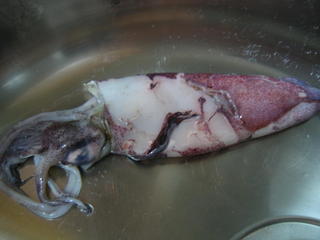
27-Nov-2005 Steve: This blog was written exactly a month ago. Despite the popularity of the dish I had been unable to answer a question that had occurred during the research into Calamar. Finally, yesterday, after unpacking Blanca's cookbooks from London, we found the answer and I could complete the recipe. Read on...
27-Oct-2005 Steve: It has been over a month, but we cooked last night for the first time in our new flat in Granada. In this blog I would like to acknowledge the contribution of various people and professions across the province of Granada to this inaugural meal:
- el notario – the town notary in Guadix
- el estanco – the newspaper stand
- el ayuntamiento – the town hall
- la dueña – the landlord
- la policía – the police
- el banco y el director de la sucursal – the bank and bank manager
- los padres – parents
- los tíos y primos – uncles, aunts and cousins
- el taller – the garage
- el portero – the porter
- la churrería – the churros restaurant
- el fontanero – the plumber
- el toldero – the awning guys
- las mudanzas – the removal company
- muebles morino – the useless kitchen fitters
- el electricista – the electrician
- el pintor – the painter
- la ferretería – the hardware store
- el tapicero – the upholsterer
- el corte inglés – supermarket where we bought the food
- and last, but by no means the least important… el butanero – the gas delivery man
As it was the first night, we wanted to cook something traditional. As we were completely wrecked, we also wanted to cook something simple. Blancs suggested arroz negro. This is a typical Spanish dish, originally from Barcelona and Valencia. With my newfound residence, strictly speaking, I should be boycotting Catalan recipes, but I'm Irish and, more importantly, people have been known to call this the "most delicious rice preparations ever invented"*. Simply put it is paella made with calamar, dyed with its own ink.
We did the shopping in El Corte Inglés, Blanca left me at the pescadería (fish counter). I managed to navigate my way to buying 3 medium calamar (calamari is Italian). I was quite happy with myself until later when she realised that I hadn’t asked for cleaned ones. Nevertheless, an unexpected techniques session came out of my mis-procurement… how to clean the calamari. This is the technique that Blancs learnt in Blagdens in London.
1. Calamari are shellfish; part of the molluscs family, as distinct from the crustacean decapods. They are cephalopods, meaning ‘head-foot’, mainly due to the proximity of their head and feet. Their sub-family is shared with squid, octopus and cuttlefish. They are the most advanced molluscs and, unlike the rest, they don’t have shells. The ink is used to evade capture… humans have a more mundane use in that it forms colour and flavour for this dish in particular.

2. The cleaning process focuses on the various parts of the body. First you must reach into the head and remove the transparent cartilaginous shield from inside the body. This is the spine and is particular to squid and calamari, the octopus doesn’t have any.
3. Grasp the tentacles and pull firmly to remove. Squid and cuttlefish have 8 ‘arms’ and 2 tentacles. Octopus has 8 tentacles. Note: both Spanish and Catalans have 2 arms and 2 legs.
4. Rinse the body and discard the purplish-black membrane. Calamari have long triangular flaps running along side the body, these are located at the narrow end of the body, cut these off, but save to eat.
5. To ensure that the head is fully clean, wash it inside out.

6. Next prepare the tentacles. Press the bunch away from you, the 'beak' will pop out. Pull away and discard. Be careful as this can cut you. I innocently thought the beak was something to do with the nose of the fish, I have since learnt it is the anus. I'm not sure how I feel about this.
7. Cut the tentacles just below the ink sac (visible as a purple bulge). Discard the remaining part.
3 medium calamari
1 sack of ink (best frozen)
3 tbsp white wine
½ onion chopped
2 garlic cloves crushed
1 cup of medium-grain rice
3 ½ cups of warm fish stock (depends on the rice type)
1 tbsp olive oil
Salt and pepper to season
The following recipe is, as mentioned above, one that works. It is taken from Penelope Casas's "The Food and Wines of Spain". Heat a pan with oil over the flame. We used a wide, flat paella pan as the cooking method is principally about leaving the rice to settle and absorb the stock rather than stir like a risotto. Add the onion and cook until translucent. Add the squid and sauté 5 minutes. Add the garlic and cook for a moment. Cover and simmer for 30 minutes.
Add the stock (boiling hot) and rice and stir in the ink and wine. Note, ink is most easily used frozen as it is less likely to stain. Season with salt and pepper. Cooking times vary depending on the rice. We were cooking with Arroz Bomba de Calasparra, this is a medium grain rice from near Murcia. Bring to the boil and cook over a medium high heat, uncovered and stirring occasionaly, for 10 minutes until the rice is no longer soupy, but some moisture remains.
Transfer to a 160C oven. Bake 15 minutes, uncovered until the liquid is absorbed, but the rice not yet done. Remove from the oven, cover lightly with foil and let sit for 10 minutes. It is then ready to eat.
The paella dish is extremely wide, in order to retain the heat and moisture (thereby prolonging the cooking time) traditionally, cooks would often place a newspaper over the pan.
So what was the reason for the month's delay?
The recipe, as you can see, is pretty straight forward. We actually used a slight variation; sauté vegetables, add the calamar, add the rice. Overall cooking time for the calamar was about 25 minutes as opposed to about 80 minutes above. The flavour was great, but the calamar was quite tough.
As with many things, the problem (but not the solution) was brought to our attention in my research into calamar...
Cephalopods have extremely thin muscle fibres reinforced by about four to five times the amount of collagen in a normal fish. This makes their cooking somewhat unusual. McGee and Stephanie Alexander are adamant that they must be cooked either briefly (2-5 minutes to prevent the muscle fibers being broken down) or for a very long time (over 1 hour in order to breakdown the collagen). “In-between” cooking results in a tough, rubbery texture.
Blanca reckons that Penelope Casas has written "the best book on Spanish cooking by a non-national". She is either making a very subtle point about Catalan independence or is measuring her words. Either way, judging by the fact that she was, so far, the only author that was able to solve our calamar problem... I'm convinced.
Enjoy.





5 comments:
I know three facts/tricks for "softer" calamar:
Frozen calamars are softer than fresh ones (pity) due to the destruction of the water-contained muscles.
Try adding 1 spoon of sodium bicarbonate (soda powder) to the calamars, let them rest for some 10-15mins and rinse (you can use it with the sopda, but your stomach will not like it THAT much, and neither your girlfriend.)
Mash some kiwi fruit and add to the calamar. Don't let more than 10mins it will dissolve!
Let me know how it went... :-)
Ah, now I see... I post with only 2-3 years of delay... :-)
Whoa I hadn't heard about this black rice, in fact I love rice so I'll make it at home and see what happens. As a fact my uncle who is always visiting
Viagra Online likes to make all about rice.
so the secret to obtain that color in the rice is the using the ink of the squid,by the way congratulations for you new place.
Looks awesome I'm gonna try this next week, thanks for the recipe.
Post a Comment